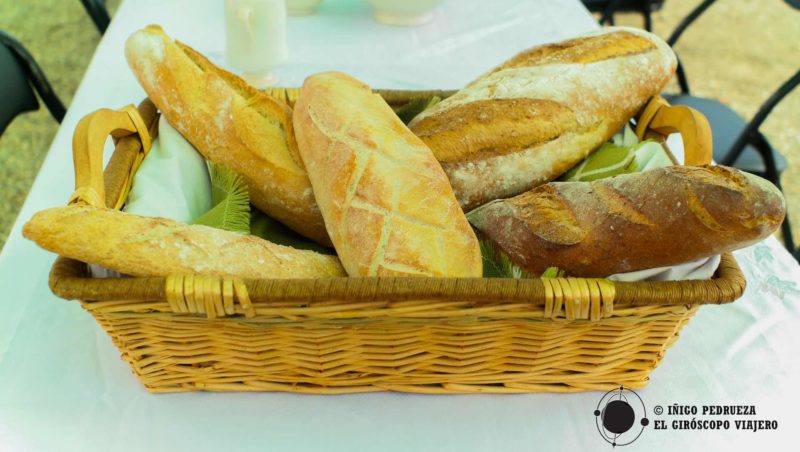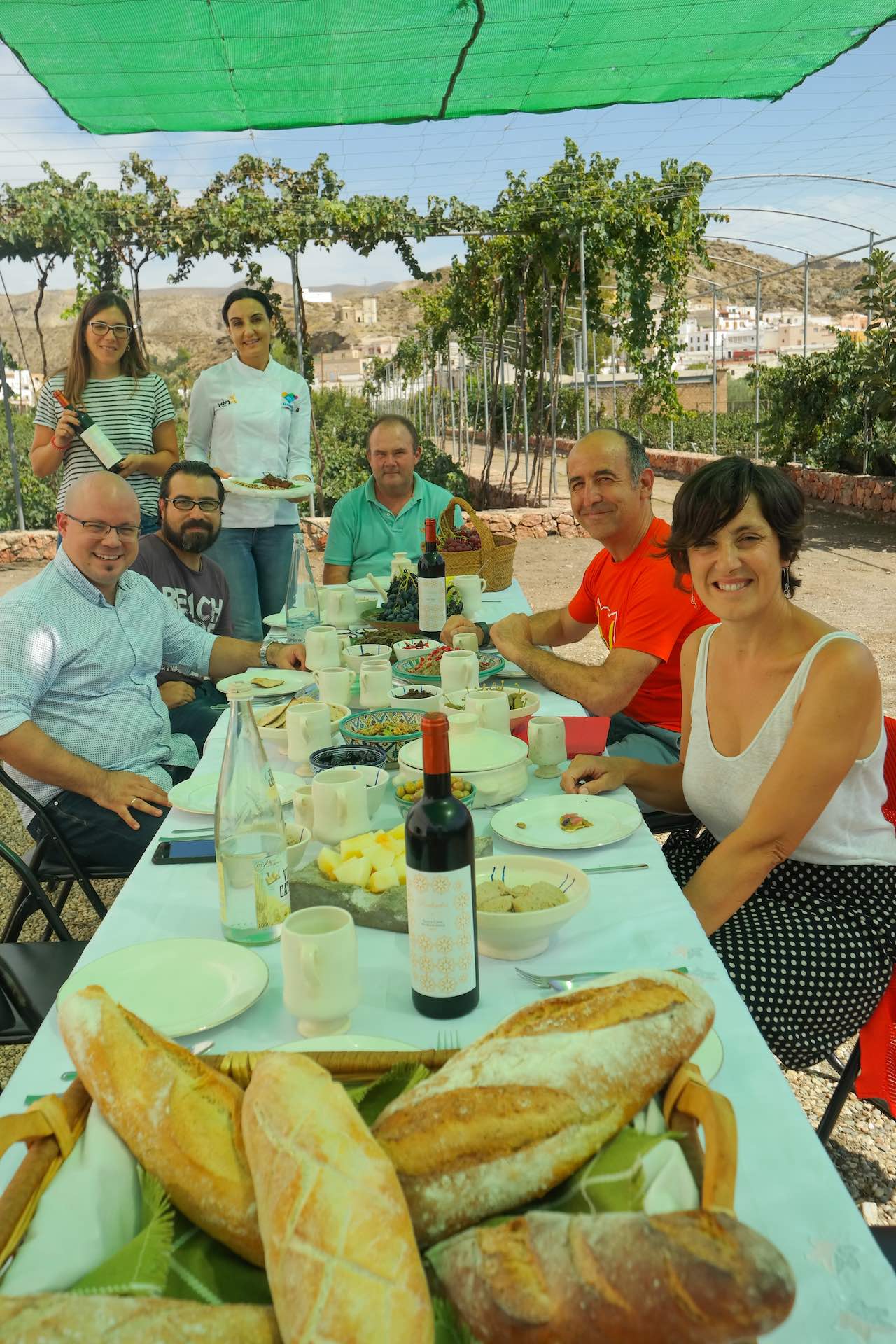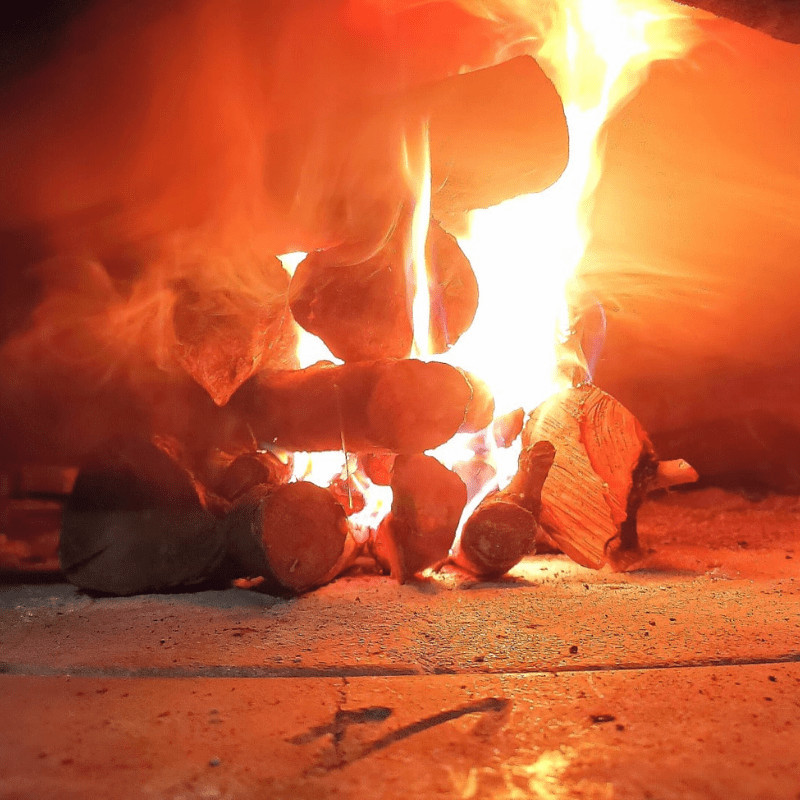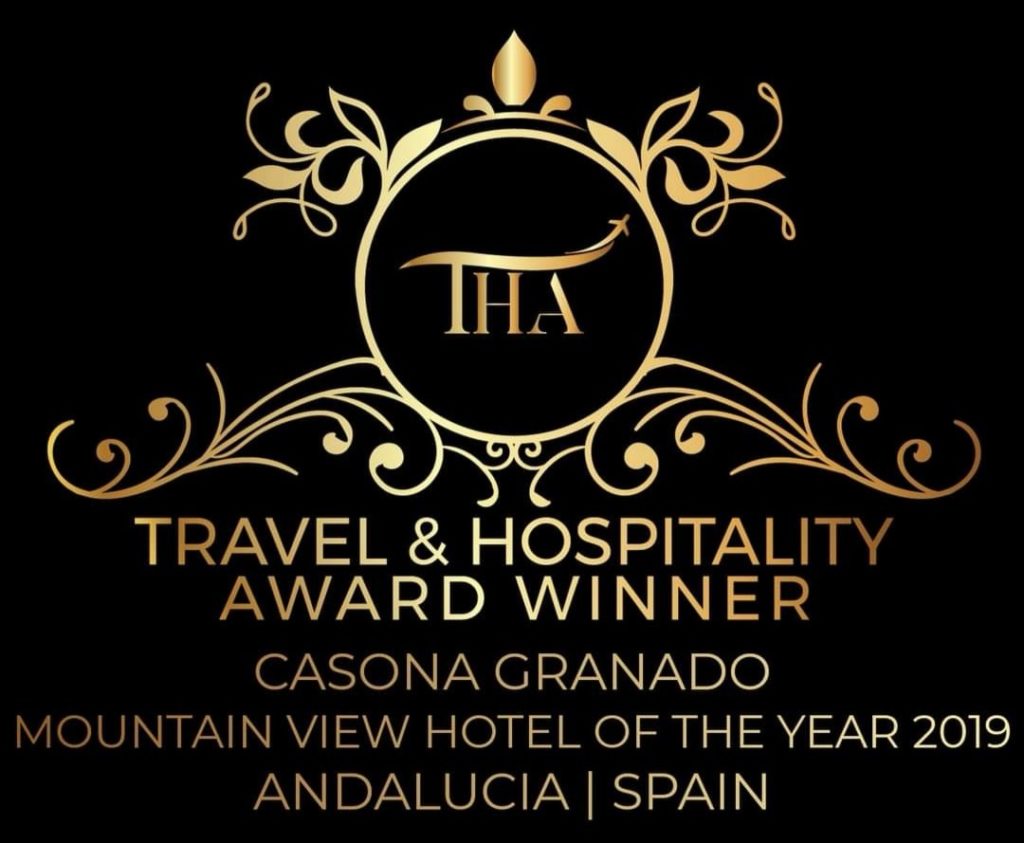Unhurried trips, stopping at places just to discover and enjoy, are conducive to moments like the one we live in the Alpujarra of Almeria. When the summer heat still warms up the days in Andalusia, despite being in late September, we travel the inland lands of Almería, far from the beauty of Cabo de Gata . We look for that other Almería that they tell us exists, and we discovered it with great hosts.
Enrique Parra , a dedicated tourism professional, who will accompany us throughout the tour of the province. And Rosa Pascual , a passionate winemaker, who will take us on a sensory journey through the Alpujarra , a journey to the flavors and smells of a landscape hitherto unknown to us. We enjoyed an intense day with the aroma of Alpujarra grapes, starting with some family wineries that have recovered the Almeria wine tradition, taking it far, with effort and intelligence: the Fuente Victoria Winery . And ending with an authentic gastronomic feast in a unique rural setting: in the middle of a vineyard in Santa Cruz de Marchena, one of those beautiful towns in the Alpujarra of Almería, where delicious wines are also being made that bring us back to earth.

This is precisely the common thread of our first journey through a less known, but fascinating Almería: the return to the land , to the production of wine and a traditional cuisine based on what nature offers us . The basic products that were part of the table of the civilizations that preceded us. That thanks to technology and modern procedures, high-quality manufactured products are being produced, and that today they have caused a real revolution of our senses. And also of the perception that we have of the products of the land and of the preparation of broths and meats. On this trip to the Alpujarra we have discovered what ‘Gastroconciencia’ is thanks to thechefs Yolanda García and Javier Martínez Zafra …, a very interesting conception of gastronomy, a sustainable cuisine based on some ideas that we had already adopted in a certain way in our day-to-day life, and others that we have made our own thanks to the good work of these cooks aware of nature, the local economy and sustainability.
Crossing the landscapes of the Alpujarra of Almería

This jewel that is the Alpujarra Almeriense shines in the middle of great wonders of Andalusia such as Sierra Nevada, the Mediterranean and the Tabernas Desert. We are going to Santa Cruz de Marchena, after crossing one of those beautiful white villages such as Laujar de Andarax, Padules or Canjáyar . Without even making a stop, we already know that we want to return to the Alpujarra, to learn more about its white villages and these fascinating landscapes. Although we will stop at Laujar de Andarax and Canjáyar, we are aware that we will not be able to see everything we want, and we immediately realize that it takes time to discover the Alpujarra Almeriense. So we can travel as we like, slowly, enjoying the landscapes, places, people, gastronomy, …

We woke up crossing the Sierra Nevada mountains from Guadix through panoramas that seemed to have been there forever, wild, silent, eternal, … Arriving in white villages of the Alpujarra Almeriense such as Bayárcal or Paterna del Río , where people seem to live at rates that today they seem from another time . Those rhythms that we should recover if we do not want to lose ourselves in the chaos of haste and oblivion. A good introduction to this journey back to the origins, to become aware of the monumental, landscape, cultural and gastronomic heritage that we have in this other Almería.
We imagine the Alpujarra Almeriense at other times of the year, when winter covers the mountains with snow and the white villages are confused with that other white. Or in spring, when everything blooms again, the rebirth of this land that is preparing to grow the fruits that it will give us later, in summer, when the heat dries up the Alpujarra. We imagine those other trips to this Almería that changes with the passing of the seasons. We postpone them to return to this late summer, almost autumn, when it is harvest time and we can almost feel the smell of ripe grapes, of juice that will soon be that wine that is beginning to be recognized in Andalusian lands.
We let ourselves be guided by the roads of the Alpujarra, in a panoramic vehicle, crossing those landscapes of imposing mountains, olive trees, vines and green valleys . Believe it or not, in Almería there are also orchards, orchards with the usual aromas and flavors. Those that we will see and taste very soon at our table.
A trip to Andalusian cuisine

A splendid day welcomes us, suffocating for two travelers from the north more accustomed to humidity and rain than to the heat of Andalusia. But at the same time, it is pleasant to feel this heat that invades us, that tells us that winter has not yet arrived, that it is reluctant to leave, a heat that settles with us in these hours, that allows today to happen.
We could not ask for a more suitable natural environment, the place where we will know that we will better taste Almeria cuisine: a vineyard in the middle of the valley that overlooks the beautiful white town of Santa Cruz de Marchena. In this vineyard, the oenologist Rosa Pascual and the winemaker Paco Márquez are trying to make the ideal wines . We take a short walk to contemplate the vineyards whose grapes await their turn in a harvest that has already begun. Very soon these wines will be kept in a very special cellar: in a cave that Paco is excavating, following the tradition of cave houses in many places in Andalusia, such as Guadix, in Granada or the province of Jaen.
We see how they install delicious cold dishes on the long table, the perfect introduction to this trip to Andalusian cuisine to which they are inviting us. We love the idea that they have chosen precisely that gastronomy that is part of the history of the Andalusia region, one of the great legacies of Al-Andalus. The chefs Javier Martínez and Yolanda García tell us that one of the main ingredients of their cuisine is history , which tells us about chefs with a great conscience, who care about investigating, about going to the sources. They tell us that they make use of the few books on gastronomy and agronomy of Al-Andalus, to learn more about this cuisine to which current western gastronomy owes so much.

They do know that for centuries this corner of the Iberian Peninsula was a true world power in terms of gastronomy. With the arrival of the Muslims in the 9th century, the economy, gastronomy and even manners and customs at the table were revolutionized. Aware of the richness of the southern lands, the Muslims introduced new crops, agricultural development, and consequently a great variety of food. Vegetables and fresh vegetables became of great importance by themselves or accompanying other dishes. And spices began to be used as a condiment in the preparation of dishes.
The little trip to Andalusian gastronomy that we are going to start shortly is a tribute to one of the cuisines that marked the fields, stoves and tables of the south of the Peninsula , and therefore that of all Western Europe. We participate in it aware of its importance and the need to recover it, and also that it is through the palate that the culture of a place is best understood. In addition, the kitchen is the perfect excuse to share precious moments of the trip.
To the table!

Before sitting down at the table, we go to the kitchen, where chefs Yolanda and Javier, helped by Ángeles, the winemaker’s wife , prepare with care and art the hot dishes that will come out little by little. We are attracted there by the aromas that the delicacies give off and also the curiosity to see them done. It is a pleasure to contemplate the elegance of their movements, the care in handling these foods, the passionate dedication in the preparation. What is happening in this kitchen is magic, it is palpable. These professional chefs, with long experience under their belt, are transforming local produce, the simplest ingredients, into deliciously prepared dishes. They do it with quick, learned movements, repeated so many times, knowing the magical power of their hands, respecting each of the ingredients that pass through them. And the best thing is to perceive the contagious emotion with which they do it. How wonderful to see that they have not lost an iota of their passion for cooking! They gracefully elaborate the Andalusian dishes that we are about to taste.
We watch them for a while longer while one of them fries some figs that take on a golden color causing an automatic salivation in our taste buds. We let them do it and we sat down at a privileged table where a winemaker, a winemaker, the guide of the Terque museums that we will visit later – the Historical-Ethnographic Museum and the Provincial Museum of the Uva del Barco -, Jose Luis Segura García, and a tourist promoter . A pity that the parish priest Jesús Martín was absent from the table , that same morning he was kind enough to teach us the history of the Holy Cross of the vow in Canjáyar, a beautiful town in the Alpujarras.

The meal is accompanied by good conversation and laughter, lasting until we get to dessert, after a tasting of starters, first and second courses that seems eternal. We savor them slowly to identify all the ingredients and stay with new flavors , others surprising, and some that become familiar, but that we had not fallen into their enormous potential, despite their simplicity.
We begin with a display of starters that attract us both for their color and their aroma. We see a cocktail grenades and aromatic Illar of the Filabres , various pates: dry with aromatic tomato and almonds, pate hare , pâté Scotch thistle! The latter was quite a surprise, we could not imagine that something so delicious could be made from borriquero thistle. And not with purslane either ! Yes, that succulent plant that we consider “weed” that spreads everywhere, and that our chefs turned into a delicious salad accompanied with caramelized figs and pomegranates with pomegranate vinaigrette. Doesn’t that sound wonderful ?!

But we can add other surprises, such as Babaganus or Baba ganush , an aubergine pâté garnished with pomegranate seeds that we had not tried before, an exotic flavor for our palate that we really liked. Ajoblanco is also new for us , here served with Alvelal almonds, a dish that we first discovered in Malaga and that won us over from the first moment. In fact, it is a very popular cold soup in the gastronomy of this province, composed of garlic, bread, ground almonds, EVOO (Extra Virgin Olive Oil) and salt. One of the most delicious flavors of our trip through Andalusia, which we will continue to taste later, throughout our journey through the region, from Malaga to Jaen.
Of course, olives are also present on the table, a product of Andalusia par excellence, and although the seas of olive groves are in Jaen, the olive trees are trees that cross all the fields and hills of Andalusia. And one of the starters that we all agreed with as excellent was the Moretum , a garlic spread cheese , flavored with herbs that was used as an accompaniment to ancient Roman dishes. To accompany the starters and main courses, a fantastic variety of wood-fired oven breads from Félix’s bakery , today from José Cortes Carmona, chia, rye and seed breads .

Little by little hot dishes were arriving , since in the kitchen they continued to do magic while we had the great feast. Until dessert, the excellent cooks did not sit at the table with us to delight us with their words and their pleasant ideas about ‘Gastroconciencia’. Yolanda presents us some delicious spicy black pudding with roasted apple puree , which is best eaten hot. Like the first course: some Gallants with white garlic with gold nuggets. The Galán is a fish also known as peine or pejepeine, which is somewhat reminiscent of red mullet, an authentic delicacy common to Almeria cuisine. Its fresh white meat, its simple flavor accompanied by ajoblanco also conquered our palate. And the best thing is that we know that this fish has been caught with gear from Cabo de Gata . As Yolanda and Javier will explain to us later, the presence of local products is essential in ‘Gastroconciencia’ .
The succulent banquet is weighing on our bellies that are quickly becoming the gastronomy of Andalusia due to the delicacies that are in it, although not so much in quantity … So it is difficult for them to continue when one of the star dishes arrives: Alcuscus Andalusian lamb safe . The Alcuscus is like the couscous, only the latter is Moroccan and the former Andalusian. And the Segura lamb is a Spanish breed that lives in the Sierras de Segura and La Sagra, and in the high areas of the banks of the Segura River, highly appreciated by the area.

We cannot stop talking about the wines that accompanied us during this meal: first of all, the non-bottled wine, freshly made by Rosa Pascual and Paco Márquez, a promising broth that invites us to return when the winery in the cave house Be prepared. The wines from the Fuente Victoria Winery , which we visited this morning, were also present. These are wines made with native grape varieties, such as Vigiriego, combining them such as Tempranillo, Syrah and Macabeo. We are conquered by whites with intense aromas. These wines are a great discovery that we made accompanied by Nacho, Pedro and Rosa, delighting us and learning a lot about a product that is making a space in the ecological panorama of Andalusia.
We thought we could no longer afford dessert, but Yolanda appeared with that carob and poppy cake with blackberry coulis , the perfect icing on the cake to the series of Andalusian delicacies that we enjoyed for hours. And as if that were not enough, Rosa appeared with the meringues of the pastry chef Cristóbal Sánchez , who runs a confectionery in Canjáyar. We had the pleasure of visiting him and tasting his inimitable meringues freshly made in a Moorish oven, we were even able to try making some ourselves, with unfortunate results!

Now our favorite cooks, those who made such magnificent Andalusian dishes, sit at the table. Between a piece of carob cake and some meringues, we listened carefully to the meaning of ‘Gastroconciencia’.
Behind the dishes … savor with ‘Gastroconciencia’
Our chefs have chosen the path of ‘Gastroconciencia’, a movement coined by Yolanda that they launch with the University of Almería and brings together “cuisine, science and consciousness” . Daring, brave, they have opted for the products that the land and the sea give us, recovering them and putting them in value .
We know that behind the beauty of these dishes prepared by Yolanda and Javier there is something more than delicious flavors that flood our palate. It is easy to read what is in each of the dishes, because they are the ones who tell us their story. Yolanda and Javier have turned to local producers in search of quality products, from fishermen, ranchers and farmers who defend a sustainable economy . From there comes the Segureño lamb, fish, vegetables, greens and wild herbs, …

In cooking with Gastroconciencia, respect for seasonality is essential , for the use of the products that the land or the sea offer us each season, without going to those who have to travel hundreds of kilometers to reach our table. Local products and ingredients are favored, which are produced locally or sold in local markets and fairs . We observe with emotion the respect they have for the work of the farmers and ranchers of Almería, and also for the fishermen of Cabo de Gata who carry out low-impact fishing.
Undoubtedly, this value that is given to producers and local products will help them survive, if the consumer returns or continues to be interested in them. The ‘Gastroconciencia’ makes us aware of its importance and also of the ” kitchen as a transforming axis of the local economy” , since wealth reverts to the territory itself. In short, this movement is committed to sustainability , to alliances with small producers and also to labor dignity .
We have seen it on our table today: local products and ingredients, the stuff of our ancestors’ dishes, and that these chefs have reinvented, making them even more attractive, always without losing their essence. A piece of the gastronomic legacy of the province of Almería was on our table today . We have also seen in this kitchen a return to simplicity and humility . We have been delighted that Yolanda has recovered the wild herbs that we hardly see when we walk through the countryside, that she shows us their uses and virtues, that she incorporates them into haute cuisine – always with a team of expert botanists and nutritionists -. We like it when he talks about “the exotic being in the unknown, not in the distant” .

We love that Javier wants to rescue the memory of a very rich cuisine in which several cultures were mixed , putting it in value and giving a new use to traditional products from which new ones can be created, conquering new palates.
We, as travelers, is precisely what we are looking for, the characteristic of the place, approaching the producers to understand their work, listening to them, testing their products and writing about it. That is why we feel so identified with ‘Gastroconsciousness’. We are delighted to see that Almería is recovering and promoting quality wines, traditional dishes ,… We have tasted them slowly, slowly; this is the trip we like. We are left with the images of Yolanda picking purslane in the morning to make her innovative salad, of Javier proudly photographing the final dishes, dishes with history as the main ingredient .
Article written by María Calvo Santos .
Thanks
We thank Turismo Costa de Almería for this invitation to discover this other Almería, which we have fallen in love with. Of course, Enrique Parra , an intelligent professional, aware and sensitive to the wonders of his land. He has made us the ideal itinerary to immerse ourselves in each of the attractions of the province, and he has given us his kind company throughout this press trip.
Many thanks to the oenologist Rosa Pascual , from Envinados Asesoría Ecológica y Enoturismo , for taking us to know the surprising Alpujarra wines, the delicious gastronomy and its cultural and monumental heritage. For accompanying us to meet Nacho, Pedro and Rosa, from Bodega Fuente Victoria, who invited us to their table and their winery and told us about the life and situation of Almeria winemakers and their wine. Congratulations for getting a place in the ecological panorama of Andalusia thanks to your delicious wines!
Congratulations also to Paco Márquez López , winemaker from Santa Cruz de Marchena – and to the head of the winery José Luis García Ruiz – who, together with Rosa Pascual, are creating wonderful wines. We hope to return to the fantastic cellar-cave that they are building to taste these wines again! Thanks also to Ángeles Pérez Ayala for inviting us and collaborating in the preparation of the meats that we taste.
Thanks to other small producers and artisans, such as Cristóbal Sánchez Rodríguez , who runs the “ Delicias de Almería ” confectionery in Canjáyar and makes delicious meringues. It was great to try to make them, despite the poor result 🙂

Thanks also to José Luis Segura García and Alejandro Buendía Muñoz from the Terque Museums , with whom we learned a lot about the history, culture and past of the province. And, of course, to the parish priest of Canjayar Jesús Martín Gómez , passionate speaker, for telling us the story of the Cruz del Voto in Canjáyar and the churches in the province.
And, finally, of course, a thousand thanks to the great chefs who prepared these dishes of Andalusian cuisine, conquering us with their flavors and the values of ‘Gastroconciencia’. With the palate we approach the producers of Almería and the land. Yolanda García , researcher and pedagogue in her project “Weeds”, and founder of an artistic mosaic company that employed women in her town (and for this she received the Entrepreneur Award of Almería and Andalusia). And Javier Martínez Zafra , who also participates in the ‘Gastroconciencia’ project, valuing the rural environment and culture, proposing a journey through history and time through gastronomy. He will soon publish his book “El Legado de Sefarad” on Judeo-Spanish cuisine.
Thanks to all these friends who welcomed us, they delighted us with such kindness, it has been a real pleasure. Hopefully the public dares to discover the lesser known Almería, where there are hardworking people trying to improve things. We, for our part, will try to do our bit.







